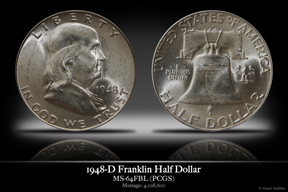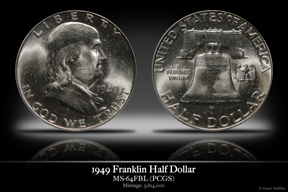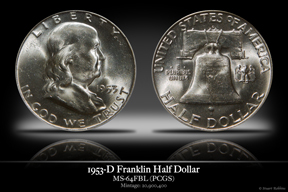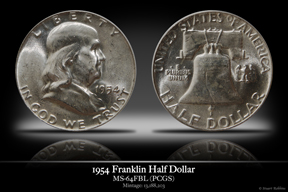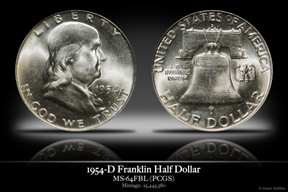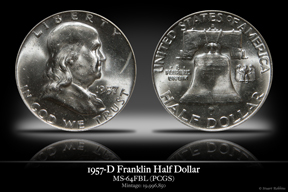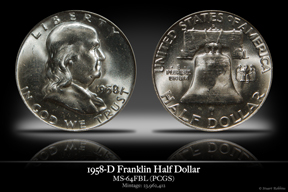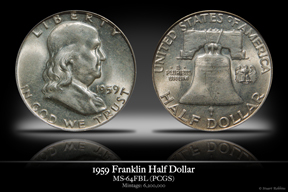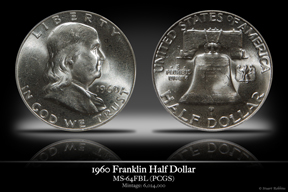Franklin Half Dollar Series,
Business Strikes
Overview of the Series
For the third design of the half dollar in the 20th century, Benjamin Franklin was chosen to replace the classic and popular Walking Liberty design. This was a fairly short-lived series, lasting only 1948-1963, a total of 26 years inclusive. The obverse features a portrait of Franklin that's rather difficult to photograph well due to the angles and relief of the nose-cheek-mouth area.
The reverse of all denominations ≥25¢ is mandated by law to have a bald eagle. However, Franklin did not want the eagle to be the national bird, rather he wanted the turkey. Taking both Franklin's wishes and the law into account, the designer placed the Philadelphia Liberty Bell as the prominent feature on the reverse along with a small depiction of the bald eagle.
Coins in the Set
A complete set of business-strike Franklins comprises 35 coins without varieties - a reasonably short set with no great rarities that can easily be obtained by even a budget collector in uncirculated condition. Proofs number an additional 14 (15 if you count the Type 1 and Type 2 1956 coins). At the moment, I am just trying to collect the business-strike set.
Things to Watch in This Series
Bag Marks: I have seen more ugly uncirculated Franlkin half dollars than a lot of other coins. Bag marks are plentiful around Franklin's cheek, jaw, head, and high points of the hair along the ear. Finding ones that are not unattractive is actually what has slowed me down in completing this series.
Strike - "Full Bell Lines:" Perhaps invented by the grading companies, perhaps not, there are a series of three lines at the base of the bell and three lines slightly higher on the bell on the reverse. If these lines are fully split (or mostly split, depending upon the grading company -- see below!), then the coin will qualify for a "FBL" or "Full Bell Lines" designation. I expand upon this in the next section.
Options in Collecting the Set
A trick to collecting Franklin halves is that, besides the standard numerical grade, coins are also categorized as to whether or not the lines on the bottom of the Liberty Bell are fully separated. Weaker strikes will have them mushed together (as in the bands on the reverse of the Mercury Dime and Roosevelt Dime, as well as the steps on Montecello on the Jefferson Nickel).
If the lines on the Bell are separated, the designation "Full Bell Lines," or "FBL" for short are added. FBL coins can be significantly more expensive than non-FBLs, commanding about 3-5x the price on average, or up to 10x (for 1962) or even 300x (for 1953-S in MS-66 vs MS-66FBL).
Note that the two main grading companies - NGC and PCGS - define "FBL" differently. PCGS in this rare case is actually less strict than NGC, requiring only the bottom three bell lines to be fully separated. NGC requires all three bottom and three top lines to be separated fully before they will give the FBL designation. As a consequence, NGC "FBL" Franklin halves will usually command a higher price than their PCGS counterparts.
Keys to the Series
In general, good strikes on the San Francisco mint coins are worse than Philidelphia and Denver. Particularly, the 1949 S and 1952 S coins in mid-MS state with the FBL designation will command a ~$200 or $500 price, respectively. The real rarity, though, is the 1953 S coin. A simple 1953 S MS-64 coin will bring in maybe $30. But, based on the auction records I could find since 2005, the coin in MS-64FBL will bring in around $10,000 and in MS-65FBL will cost you $25,000.
Otherwise, the price inflection point for the Franlkins is generally around the MS-65 grade where coins MS-64FBL are in the $10s and don't cost too much more by going up a grade, whereas at MS-65FBL and higher, they can go up by several hundred dollars.
My Collecting Goal
I have chosen to collect a set of business strikes at the MS-64FBL grade. If I ever decide to include proofs, I will likely aim for PR-64DC, as well. Of course, for the incredibly expensive examples, such as those I quoted above, I will settle for non-FBL examples but still stick with MS-64. This set is likely to run around $3000 to complete in that grade.
A Note on the Photographs: Because I'm collecting these in PCGS slabs, it is very difficult to take good photos of the coins because (1) I'm photographing through thick plastic, and (2) that plastic is scratched and has dust that accumulates no matter how many times I wipe it off. So keep in mind that the actual coins look better than the photographs make them out to be.
Checklist
| DATE | HAVE? | GRADE |
| 1948 | ||
| 1948 D | YES | MS-64FBL |
| 1949 | YES | MS-64FBL |
| 1949 D | ||
| 1949 S | ||
| 1950 | YES | MS-64FBL |
| 1950 D | ||
| 1951 | YES | MS-64FBL |
| 1951 D | ||
| 1951 S | YES | MS-64FBL |
| 1952 | YES | MS-64FBL |
| 1952 D | ||
| 1952 S | ||
| 1953 | ||
| 1953 D | YES | MS-64FBL |
| 1953 S | ||
| 1954 | YES | MS-64FBL |
| 1954 D | YES | MS-64FBL |
| 1954 S | ||
| 1955 | YES | MS-64FBL |
| 1956 | ||
| 1957 | ||
| 1957 D | YES | MS-64FBL |
| 1958 | ||
| 1958 D | YES | MS-64FBL |
| 1959 | YES | MS-64FBL |
| 1959 D | YES | MS-64FBL |
| 1960 | YES | MS-64FBL |
| 1960 D | ||
| 1961 | ||
| 1961 D | ||
| 1962 | YES | MS-64FBL |
| 1962 D | ||
| 1963 | ||
| 1963 D |
